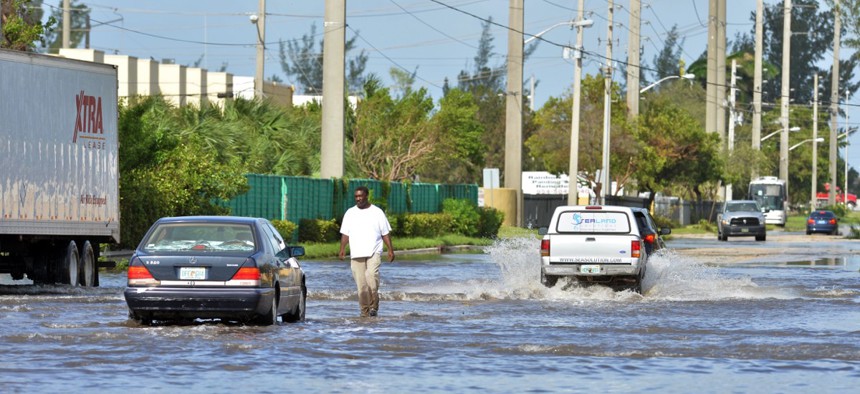Getting Ahead of Hurricanes With Data-Driven Evacuation Planning

Fort Lauderdale, Florida after Hurricane Irma MediaPunch / AP Photo
A growing number of cities are looking to do more with transportation data analytics before disasters strike.
Hurricanes Harvey, Irma and Maria and the two recent earthquakes that hit Mexico have local officials understandably revisiting evacuation planning, which in many cases amounts to a neat visualization of regional traffic or Twitter activity with relatively little real data analysis.
In particular, hurricanes generally come with a few days of advance notice that afford governments a window to study typical traffic patterns in the area and identify those routes most likely to flood.
Cities should familiarize themselves with standard traffic configurations during rush hour, sporting events and previous disasters, while maintaining a healthy understanding that the bottlenecks that arise in extreme situations may differ from the norm.
“It’s more than just visualizing what’s happened,” said Laura Schewel, CEO and cofounder of San Francisco-based mobility analytics company StreetLight Data. “It’s trying to create knowledge for the next hurricanes that come.”
StreetLight’s online, cloud-based platform lets transportation officials study otherwise costly, hard-to-acquire travel data—like the percentage of drivers traveling north on a particular highway headed for a specific destination—from GPS-enabled smartphones and connected cars among other sources. The software has been used by government agencies to plan about 400 infrastructure projects nationwide this year, though StreetLight has helped several New England cities with evacuation planning, Schewel said.
“Most of our clients use us for infrastructure planning and policymaking,” she said. “And really evacuation planning is just extreme infrastructure planning and policymaking.”
During a disaster, cities should already know those communities that are most and least likely to evacuate based on previous evacuations, what will get them to leave, when and where they’ll go.
Earthquakes provide less notice and terrorist or bomb threats none, so agencies need preset scenarios in place that they can drop into depending on the situation. Baseline data on how the population should be distributed on, say, a typical Tuesday in October fills in the gaps, even if communications go down.
With transportation infrastructure aging past its usefulness in many cities, the rise of ridesharing, online ordering decreasing travel to and from stores, and the advent of autonomous vehicles, agencies become paralyzed if they can’t query their data.
For instance, it’s important cities understand not just where but why a traffic jam is occurring. Perhaps encouraging bike ridership for those traveling short distances could “bust” congestion, Schewel said.
Parking poses an interesting dilemma for cities because drivers want it and cities collect revenue of it, but limiting spaces could be the push people need to take the bus or alternate modes of transportation. Data can tell you where most drivers are idling in search of parking on the road, to inform changes like park and rides for subways that make them more effective.
Schewel calls the phenomenon where hundreds of vehicles are bumper to bumper along a possible bus route a “ghost bus.” Employee shuttles might provide a solution or else rerouting by changing egresses.
Then there’s the land use component to transportation. A poorly sited Whole Foods might be drawing drivers to travel excessive miles, so a closer one might be favorable.
If a major construction project is causing congestion or standstills, telecommuting is an option. In Colorado, the Boulder-Denver Corridor informed employers of a major road project in advance for that reason.
“We’re talking about big data mixed with software that makes it useful,” Schewel said. “Now is the time to start doing analysis and planning before the next ‘big one’ hits.”
Dave Nyczepir is a News Editor at Government Executive’s Route Fifty and is based in Washington, D.C.
NEXT STORY: CMS fraud prevention system stops billions in improper payments






